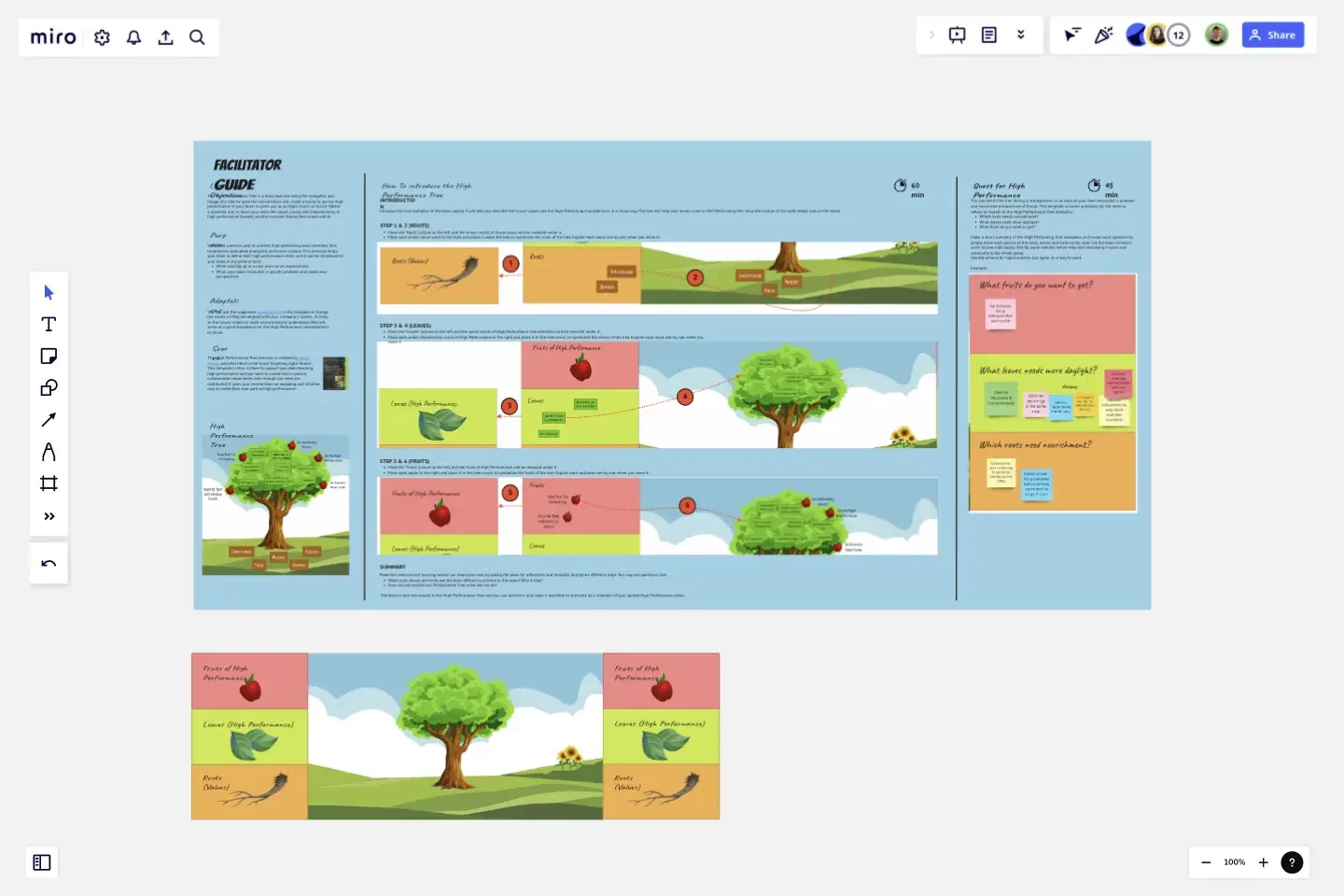Team´s High Performance Tree
The High Performance Tree is a team exercise using the metaphor and image of a tree, to spark the conversation and create a vision to pursue high performance in your team.
Learning Objective
The High Performance Tree gives you as an Agile Coach or Scrum Master a powerful tool to teach your team the values (roots), the characteristics of high performance (leaves) and the outcome (fruits) that comes with it.
Purpose
With a set common goal to achieve, high-performing team members find themselves motivated, energized, and more creative. This exercise helps your team to define their high performance vision and it can be introduced to your team at any point of time;
When starting up as a new team to set expectations
When your team encounter a specific problem and needs new perspectives
Adaptions
You can use the suggested Scrum Values in the template or change the words so they are aligned with your company ́s values. As long as the values relates to Agile and are easy to understand, they will serve as a good foundation for the High Performance characteristics to thrive.
Source
The High Performance Tree exercise is created by Lyssa Adkins and described in her book “Coaching Agile Teams”. This template in Miro is there to support you when teaching high performance and you want to create that in-person collaboration experience, even though you team are distributed. It gives your remote team an engaging and intuitive way to create their own path to high performance!
This template was created by Johanna Torstensson.
Get started with this template right now.
DevOps Roadmap Template
Works best for:
Documentation, Product Management, Software Development
DevOps teams are constantly creating code, iterating, and pushing it live. Against this backdrop of continuous development, it can be hard to stay abreast of your projects. Use this DevOps Roadmap template to get a granular view of the product development process and how it fits into your organization's product strategy. The DevOps Roadmap lays out the development and operations initiatives you have planned in the short term, including milestones and dependencies. This easy-to-use format is easily digestible for audiences such as product, development, and IT ops.
Midnight Sailboat Retrospective
Works best for:
Retrospectives, Meetings, Agile Methodology
The Midnight Sailboat Retrospective template offers a metaphorical journey through past experiences and future aspirations, likening the retrospective process to a midnight sailboat voyage. It provides elements for reflecting on challenges faced, lessons learned, and goals for the future. This template enables teams to navigate uncertainties, chart a course for success, and foster a culture of resilience. By promoting reflection and metaphorical thinking, the Midnight Sailboat Retrospective empowers teams to overcome obstacles, embrace change, and sail towards their goals effectively.
Skill Cards
Works best for:
Agile
Skill Cards are a dynamic tool for assessing and developing skill sets within Agile teams. They provide a structured framework for reflecting on strengths, weaknesses, and learning goals, fostering a culture of continuous improvement. With Skill Cards, teams can identify skill gaps, distribute knowledge, and tailor professional development plans, empowering you to cultivate a high-performing team with diverse skill sets and shared expertise.
Penny Game
Works best for:
Agile
The Penny Game is a simulation exercise that illustrates the impact of batch size and work in progress on cycle time and throughput. By tracking the flow of pennies through a production system, teams learn how to identify bottlenecks, optimize processes, and improve efficiency. This template offers a practical way to explore Lean principles and drive continuous improvement, empowering teams to streamline their workflow and deliver value more predictably.
FMEA Analysis Template
Works best for:
Agile Methodology, Strategic Planning, Software Development
When you’re building a business or running a team, risk comes with the territory. You can’t eliminate it. But you CAN identify it and mitigate it, to up your odds of success. Failure Modes and Effects Analysis (FMEA) is a powerful tool designed to help you manage risk and potential problems by spotting them within a process, product, or system. And you’ll spot them earlier in your process—to let you sidestep costly changes that arise late in the game or, worse, after they’ve impacted your customers and their experience.
Scrum Puzzle
Works best for:
Agile
The Scrum Puzzle is a collaborative activity that reinforces Scrum roles, artifacts, and ceremonies. By assembling a puzzle representing the Scrum framework, teams gain a deeper understanding of its components and how they interrelate. This template offers a fun and interactive way to reinforce Scrum knowledge and promote team alignment, empowering practitioners to apply Scrum principles effectively and deliver value with agility.
